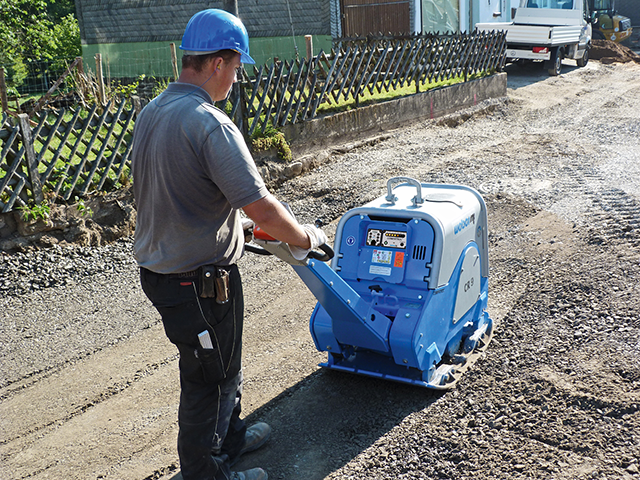How to choose the best Compactor

Plate compactors come in handy where large rollers are just too big, eg. jobs such as laying patios and paver stones, asphalt driveways or doing landscaping. They’re all heavy, powerful machines so how do you choose the right one? Let’s look at the different things to consider and review a couple of the models on the market right now.
Single direction plate compactors
These only go forward but they’re easier to transport and use. These are great for standard hard fill, pavers and asphalt jobs (as long as they’re not too big). A must have for landscapers, builders, and civil contractors.
Reversible plate compactors
These go forward and backwards and because they’re much bigger and heavier, often used for sub base or deeper depth compaction. That does makes transporting and setting up the compactor a tricky job, potentially one the will need its own specialist equipment. Perfect for foundations, roading contractors and the like.
The handle
Handles play a role in how easy and comfortable the machine is to use. Some have a basic bar at the back, similar to a push-mower. Centrally mounted handles make for easier movement; same with swing handles – these can be mounted centrally or at the back and allow for greater maneuverability and operator comfort. Check out the Weber MT range – these have among the lowest vibration and most comfortable handles on the market.
Width, weight, force & VPM
Choosing the right compactor based on the physical size of the plate is obvious – wider plates cover more ground in one pass. The centrifugal force it puts out also needs to be considered; not enough and you won’t be able to do the job. Too much and you’ll destroy the work that’s already been done. But don’t be fooled into thinking how hard the plate ‘hits’ is where all the value lies. How big it is and how much the compactor weighs are also important in determining best performance. number of vibrations per minute (VPM) is also critical. For asphalt and granular materials you’ll need a higher VPM, and lower for cohesive soils compaction.
The plate itself
What is it made of? Cast ductile iron base plate tend to be more efficient because they’re more rigid. Is it curved? Curved plates can be easier to turn, making it less likely you’ll gouge the surface while you work. Weber MT models also have self-cleaning base plates, for less wear and tear from material buildup around and underneath the plate.
Other bits
If doing asphalt, a water tank can help stop it sticking by creating a barrier between the hot ground and cold plate.
Let’s compare a few models; we’ve chosen two smaller single-plates and a heftier reversible model:
Wacker Neuson VP 1340A Value Vibratory Soil Plate
- Made by a well-known construction equipment brand
- Special contoured running surface with rounded edges for optimal maneuverability and performance.
- Enclosed belt with protective guard means reduced wear
- Designed for minimal maintenance
- Ergonomically designed lifting handles for easy loading and unloading on site
- 30% reduction in vibration
- Engine - air-cooled, 4-cycle, single cylinder Honda petrol
- uses under 2L of fuel per hour
- Good for medium to heavy-duty projects
- Fuel usage: approx. 1.8L per hour
- Weight: 74kg
- Height 90cm
- Plate size: 40x58cm
- Speed: 22m per minute
- VPM: 5800
Multiquip MVC82VHW Honda GX160 Plate Compactor with Water Tank
- Solid, high-strength steel base plate with curved edges
- Smooth turns on hot asphalt
- Excellent performance reviews from customers
- Ideal for compacting granular soil or asphalt
- 50% reduction in vibration
- Highly maneuverable
- Great in confined or tight spots
- Easy start-up
- Engine and belt protection features for longer life
- Cog-tooth belt drive offers longer life (vs V-belt)
- Water tank holds 11L
- Anti-vibration design to reduce operator fatigue
- Durable construction
- Designed for medium to heavy-duty projects
- Fuel usage: approx. 1.2L per hour
- Weight: 90kg
- Height 100cm
- Plate size: 46x57cm
- Speed: 22m per minute
- VPM: 5600
Weber MT CR5 273 kg Reversible Plate Compactor
- Performs over long hours
- Designed for compaction of sand, gravel, crushed aggregates and garden or patio pavers
- Forward and reverse travel
- Infinitely variable hydraulic control allows precise work even under adverse conditions
- Robust protection frame prevents engine damage
- Diesel version with electric start and engine guard
- Self-adjusting centrifugal clutch for low-maintenance
- Large, fixed lifting lug for quick loading by fork lift
- Excellent price/performance ratio
- Honda GX 270 engine
- Operating Width 55cm
- Engine Output 4.6 kW(6.2hp) 5.1 kW(7hp)
- Weight: 281kg
- VPM: 4200
Need more help choosing the right compactor? Get in touch with our knowledgeable team, tell them your needs and we’ll find the right fit.